Predictive Potential of Maize Yield in the Mesoregions of Northeast Brazil
Abstract
:1. Introduction
2. Materials and Methods
2.1. Data and Area of Study
2.2. Canonical Correlation Analysis
3. Results and Discussion
3.1. Relation between Rainfall and Production
3.2. Results Obtained by the CCA Model
3.3. Results by State—Maranhão
3.4. Results by State—Piauí
3.5. Results by State—Ceará
3.6. Results by State—Rio Grande do Norte
3.7. Results by State—Paraíba
3.8. Results by State—Pernambuco
3.9. Results by State—Alagoas and Sergipe
3.10. Results by State—Bahia
3.11. Ocean-Atmosphere Interaction versus Production
4. Conclusions
Author Contributions
Funding
Data Availability Statement
Acknowledgments
Conflicts of Interest
References
- CONAB—Companhia Nacional de Abastecimento. Acompanhamento da Safra Brasileira de Grãos, safra 1019/20 (Quinto levantamento). Brasília, DF, v. 7 (5), 1–112; 2020. Available online: https://www.conab.gov.br/info-agro/safras/graos/boletim-da-safra-de-graos/item/download/45055_d5c43cb0752e5b39bc31987286081f88 (accessed on 5 August 2023).
- CONAB—Companhia Nacional de Abastecimento. Acompanhamento da Safra Brasileira de Grãos, safra 2023/24 (Quarto levantamento). Brasília, DF, v. 11 (4), 1–111; 2024. Available online: https://www.conab.gov.br/info-agro/safras/graos/boletim-da-safra-de-graos/item/download/51274_e40f1bba791d27a4c67a29c5f29781ff (accessed on 1 February 2024).
- Bothast, R.J.; Schlicher, M.A. Biotechnological processes for conversion of corn into ethanol. Appl. Microbiol. Biotechnol. 2005, 67, 19–25. [Google Scholar] [CrossRef]
- ABIMILHO. Associação Brasileira das Indústrias de Milho. Milho. 2020. Available online: http://www.abimilho.com.br/milho/cereal (accessed on 25 November 2023).
- Devide, A.C.P.; Ribeiro, R.L.D.; Valle, T.L.; Almeida, D.L.; Castro, C.M.; Feltran, J.C. Produtividade de raízes de mandioca consorciada com milho e caupi em sistema orgânico. Bragantia 2009, 68, 145–153. [Google Scholar] [CrossRef]
- Souza, A.E.; Reis, J.G.M.; Raymundo, J.C.; Pinto, R.S. Estudo da produção do milho no Brasil. S. Am. Dev. Soc. J. 2018, 4, 182–194. [Google Scholar] [CrossRef]
- Garnett, E.R.; Khandekar, M.L. The impact of large-scale atmospheric circulations and anomalies on Indian monsoon droughts and floods and on world grain yields—A statistical analysis. Agric. For. Meteorol. 1992, 61, 113–128. [Google Scholar] [CrossRef]
- Silva, B.K.d.N.; Costa, R.L.; Silva, F.D.d.S.; Vanderlei, M.H.G.d.S.; da Silva, H.J.F.; Júnior, J.B.C.; Costa Júnior, D.S.d.; Pedra, G.U.; Pérez-Marin, A.M.; Silva, C.M.S.e. Proposal of an Agricultural Vulnerability Stochastic Model for the Rural Population of the Northeastern Region of Brazil. Climate 2023, 11, 211. [Google Scholar] [CrossRef]
- Cavalcante, E.S.; Lacerda, C.F.; Costa, R.N.T.; Gheyi, H.R.; Pinho, L.L.; Bezerra, F.M.S.; Oliveira, A.C.; Canjá, J.F. Supplemental irrigation using brackish water on maize in tropical semi-arid regions of Brazil: Yield and economic analysis. Sci. Agric. 2021, 78, e20200151. [Google Scholar] [CrossRef]
- Cruz, J.C.; Pereira Filho, I.A.; Alvarenga, R.C.; Gontijo Neto, M.M.; Viana, J.H.M.; de Oliveira, M.F.; Matrangolo, W.J.R.; de Albuquerque Filho, M.R. EMBRAPA Milho e Sorgo: Cultivo do Milho, Sistemas de Produção, v. 2 (6). 2010. Available online: https://ainfo.cnptia.embrapa.br/digital/bitstream/item/27037/1/Plantio.pdf (accessed on 5 January 2024).
- Coelho, D.T.; Dale, R.F. An energy-crop growth variable and temperature function for predicting corn growth and development: Planting to silking. Agron. J. 1980, 72, 503–510. [Google Scholar] [CrossRef]
- Bonhomme, R. Bases and limits to using “degree-day” units. Eur. J. Agron. 2000, 13, 1–10. [Google Scholar] [CrossRef]
- Guiscem, J.M.; Sans, L.M.A.; Nakagawa, J.; Cruz, J.C.; Pereira Filho, I.A.; Mateus, G.P. Crescimento e desenvolvimento da cultura do milho (Zea mays L.) em semeadura tardia e sua relação com graus-dia e radiação solar global. Rev. Bras. Agrometeorol. 2001, 9, 215–260. [Google Scholar]
- Streck, N.A.; Lago, I.; Gabriel, L.F.; Samboranha, F.K. Simulating maize phenology as a function of air temperature with a linear and a nonlinear model. Pesqui. Agropecuária Bras. 2008, 43, 449–455. [Google Scholar] [CrossRef]
- Lacerda, F.F.; Nobre, P.; Sobral, M.C.; Lopes, G.M.B.; Chou, S.C.; Assad, E.D.; Brito, E. Long-term temperature and rainfall trends over northeast Brazil and Cape Verde. Earth Sci. Clim. Chang. 2015, 6, 296. [Google Scholar]
- Oliveira, P.T.; Santos e Silva, C.M.; Lima, K.C. Climatology and trend analysis of extreme precipitation in subregions of Northeast Brazil. Theor. Appl. Climatol. 2016, 130, 77–90. [Google Scholar] [CrossRef]
- Martins, M.A.; Tomasella, J.; Rodriguez, D.A.; Alvalá, R.C.; Giarolla, A.; Garofolo, L.L.; Júnior, J.L.S.; Paolicchi, L.T.; Pinto, G.L. Improving drought management in the Brazilian semiarid through crop forecasting. Agric. Syst. 2018, 160, 21–30. [Google Scholar] [CrossRef]
- Martins, M.A.; Tomasella, J.; Dias, C.G. Maize yield under a changing climate in the Brazilian Northeast: Impacts and adaptation. Agric. Water Manag. 2019, 216, 339–350. [Google Scholar] [CrossRef]
- Marengo, J.A.; Torres, R.R.; Alves, L.M. Drought in Northeast Brazil-past, present, and future. Theor. Appl. Climatol. 2016, 129, 1189–1200. [Google Scholar] [CrossRef]
- Cunha, A.P.M.A.; Alvalá, R.C.S.; Nobre, C.A.; Carvalho, M.A. Monitoring vegetative drought dynamics in the Brazilian semiarid Region. Agric. For. Meteorol. 2015, 214, 494–505. [Google Scholar] [CrossRef]
- Cunha, A.P.M.A.; Tomasella, J.; Ribeiro-Neto, G.G.; Brown, M.; Garcia, S.R.; Brito, S.B.; Carvalho, M.A. Changes in the spatial-temporal patterns of droughts in the Brazilian Northeast. Atmos. Sci. Lett. 2018, 19, e855. [Google Scholar] [CrossRef]
- Cunha, A.P.M.A.; Zeri, M.; Leal, K.D.; Costa, L.; Cuartas, L.A.; Marengo, J.A.; Tomasella, J.; Vieira, R.M.; Barbosa, A.A.; Cunningham, C.; et al. Extreme Drought Events over Brazil from 2011 to 2019. Atmosphere 2019, 10, 642. [Google Scholar] [CrossRef]
- Alvala, R.C.S.; Cunha, A.P.M.A.; Brito, S.S.B.; Seluchi, M.E.; Marengo, J.A.; Moraes, O.L.L.; Carvalho, M.A. Drought monitoring in the Brazilian Semiarid region. An. Acad. Bras. Ciências 2017, 91, e20170209. [Google Scholar] [CrossRef]
- Medeiros, F.J.; Oliveira, C.P.; Avila-Diaz, A. Evaluation of extreme precipitation climate indices and their projected changes for Brazil: From CMIP3 to CMIP6. Weather Clim. Extrem. 2022, 38, 100511. [Google Scholar] [CrossRef]
- Pontes Filho, J.D.; Souza Filho, F.d.A.; Martins, E.S.P.R.; Studart, T.M.d.C. Copula-Based Multivariate Frequency Analysis of the 2012–2018 Drought in Northeast Brazil. Water 2020, 12, 834. [Google Scholar] [CrossRef]
- Marengo, J.A.; Galdos, M.V.; Challinor, A.; Cunha, A.P.; Marin, F.R.; Vianna, M.S.; Alvala, R.C.S.; Alves, L.M.; Moraes, O.L.; Bender, F. Drought in Northeast Brazil: A review of agricultural andpolicy adaptation options for food security. Clim. Resil. Sustain. 2021, 1, e17. [Google Scholar] [CrossRef]
- Costa, R.L.; Barros Gomes, H.; Cavalcante Pinto, D.D.; da Rocha Júnior, R.L.; dos Santos Silva, F.D.; Barros Gomes, H.; Lemos da Silva, M.C.; Luís Herdies, D. Gap Filling and Quality Control Applied to Meteorological Variables Measured in the Northeast Region of Brazil. Atmosphere 2021, 12, 1278. [Google Scholar] [CrossRef]
- Mason, S.J.; Tippett, M.K. (Eds.) Climate Predictability Tool Version 15.5.10; Columbia University Academic Commons: New York, NY, USA, 2017. [Google Scholar]
- Esquivel, A.; Llanos-Herrera, L.; Agudelo, D.; Prager, S.D.; Fernandes, K.; Rojas, A.; Valencia, J.J.; Ramirez-Villegas, J. Predictability of seasonal precipitation across major crop growing areas in Colombia. Clim. Serv. 2018, 12, 36–47. [Google Scholar] [CrossRef]
- Hossain, M.Z.; Azad, M.A.K.; Karmakar, S.; Mondal, M.N.I.; Das, M.; Rahman, M.M.; Haque, M.A. Assessment of Better Prediction of Seasonal Rainfall by Climate Predictability Tool Using Global Sea Surface Temperature in Bangladesh. Asian J. Adv. Res. Rep. 2019, 4, 1–13. [Google Scholar] [CrossRef]
- Barnston, A.G.; Tippett, M.K. Do Statistical Pattern Corrections Improve Seasonal Climate Predictions in the North American Multimodel Ensemble Models? J. Clim. 2017, 30, 8335–8355. [Google Scholar] [CrossRef]
- Horel, J.D. A Rotated Principal Component Analysis of the Interannual Variability of the Northern Hemisphere 500 mb Height Field. Mon. Weather Rev. 1981, 109, 2080–2092. [Google Scholar] [CrossRef]
- Kirtman, B.P.; Min, D.; Infanti, J.M.; Kinter, J.L.; Paolino, D.A.; Zhang, Q.; Van Den Dool, H.; Saha, S.; Mendez, M.P.; Becker, E.; et al. The North American multimodel ensemble: Phase-1 seasonal-to-interannual prediction; phase-2 toward developing intraseasonal prediction. Bull. Am. Meteorol. Soc. 2014, 95, 585–601. [Google Scholar] [CrossRef]
- Wang, Q.J.; Shao, Y.; Song, Y.; Schepen, A.; Robertson, D.E.; Ryu, D.; Pappenberger, F. An evaluation of ECMWF SEAS5 seasonal climate forecasts for Australia using a new forecast calibration algorithm. Environ. Model. Softw. 2019, 122, 104550. [Google Scholar] [CrossRef]
- Araújo, M.L.S.; Sano, E.E.; Bolfe, E.L.; Santos, J.R.N.; dos Santos, J.S.; Silva, F.B. Spatiotemporal dynamics of soybean crop inthe Matopiba region, Brazil (1990–2015). Land Use Policy 2019, 80, 57–67. [Google Scholar] [CrossRef]
- Lima, C.H.R.; Kwon, H.-H.; Kim, H.J. Sparse Canonical Correlation Analysis Postprocessing Algorithms for GCM Daily Rainfall Forecasts. J. Hydrometeorol. 2022, 23, 1705–1718. [Google Scholar] [CrossRef]
- Salvador, M.A.; Brito, J.I.B. Trend of annual temperature and frequency of extreme events in the MATOPIBA region of Brazil. Theor. Appl. Climatol. 2018, 133, 253–261. [Google Scholar] [CrossRef]
- dos Reis, L.C.; Silva, C.M.S.; Bezerra, B.G.; Mutti, P.R.; Spyrides, M.H.C.; da Silva, P.E. Analysis of Climate Extreme Indices in the MATOPIBA Region, Brazil. Pure Appl. Geophys. 2020, 177, 1. [Google Scholar] [CrossRef]
- Assad, E.D.; Marin, F.R.; Pinto, H.S.; Zullo Júnior, J. Mudanças climáticas e agricultura: Uma abordagem agroclimatológica. Ciência Ambiente 2007, 34, 169–182. [Google Scholar]
- Pereira, C.N.; Castro, C.N.D.; Porcionato, G.L. Expansão da agricultura no MATOPIBA e impactos na infraestrutura regional. Rev. Econ. Agrícola 2018, 65, 15–33. [Google Scholar] [CrossRef]
- Utida, G.; Cruz, F.W.; Etourneau, J.; Bouloubassi, J.; Schefuß, E.; Vuille, M.; Novello, V.F.; Prado, L.F.; Sifeddine, A.; Klein, V.; et al. Tropical South Atlantic influence on Northeastern Brazil precipitation and ITCZ displacement during the past 2300 years. Sci. Rep. 2019, 9, 1698. [Google Scholar] [CrossRef] [PubMed]
- Marengo, J.A.; Alves, L.M.; Alvala, R.C.C.; Cunha, A.P.M.A.; Brito, S.B.; Moraes, O.L.L. Climatic characteristics of the 2010–2016 drought in the semiarid Northeast Brazil region. An. Acad. Bras. Ciências 2018, 90, 1973–1985. [Google Scholar] [CrossRef]
- Pezzi, L.P.; Quadro, M.F.L.; Souza, E.B.; Miller, A.J.; Rao, V.B.; Rosa, E.B.; Santini, M.F.; Bender, A.; Souza, R.B.; Cabrera, M.J.; et al. Oceanic SACZ produces an abnormally wet 2021/2022 rainy season in South America. Sci. Rep. 2023, 13, 1455. [Google Scholar] [CrossRef] [PubMed]
- de Morais, M.D.C.; Gan, M.A.G.; Yoshida, M.C. Features of the upper tropospheric cyclonic vortices of Northeast Brazil in life cycle stages. Int. J. Climatol. 2021, 41, E39–E58. [Google Scholar] [CrossRef]
- Carvalho, M.A.V.; Oyama, M.D. Variabilidade da largura e intensidade da Zona de Convergência Intertropical Atlântica: Aspectos observacionais. Rev. Bras. Meteorol. 2013, 28, 305–316. [Google Scholar] [CrossRef]
- Gomes, H.B.; Ambrizzi, T.; Da Silva, B.F.P.; Hodges, K.; Dias, P.L.S.; Herdies, D.; Silva, M.C.L.; Gomes, H.B. Climatology of easterly wave disturbances over the tropical South Atlantic. Clim. Dyn. 2019, 53, 1393–1411. [Google Scholar] [CrossRef]
- Veber, M.E.; Fedorova, N.; Levit, V. Desenvolvimento de Atividades Convectivas Sobre a Região Nordeste do Brasil, Organizada Pela Extremidade Frontal. Rev. Bras. Meteorol. 2020, 35, 995–1003. [Google Scholar] [CrossRef]
- Lyra, M.J.A.; Fedorova, N.; Levit, V. Mesoscale convective complexes over northeastern Brazil. J. S. Am. Earth Sci. 2022, 118, 103911. [Google Scholar] [CrossRef]
- Gonzalez, R.A.; Andreoli, R.V.; Candido, L.A.; Kayano, M.T.; Souza, R.A.F. A influência do evento El Niño—Oscilação Sul e Atlântico Equatorial na precipitação sobre as regiões norte e nordeste da América do Sul. Acta Amaz. 2013, 43, 469–480. [Google Scholar]
- Alves, J.M.; Repelli, C.A. A variabilidade pluviométrica no setor norte do nordeste e os eventos El Nino-Oscilação Sul (ENOS). Rev. Bras. Meteorol. 1992, 7, 583–592. [Google Scholar]
- Martins, E.S.P.R.; Coelho, C.A.S.; Haarsma, R.; Otto, F.E.L.; King, A.D.; Van Oldenborgh, G.J.; Kew, S.; Philip, S.; Júnior, F.C.V.; Cullen, H. A multimethod attribution analysis of the prolonged northeast Brazil hydrometeorological drought (2012–16). Bull. Am. Meteorol. Soc. 2018, 99, 65–69. [Google Scholar] [CrossRef]
- Kouadio, Y.K.; Servain, J.; Machado, L.A.T.; Lentini, C.A.D. Heavy Rainfall Episodes in the Eastern Northeast Brazil Linked to Large-Scale Ocean-Atmosphere Conditions in the Tropical Atlantic. Adv. Meteorol. 2012, 2012, 369567. [Google Scholar] [CrossRef]
- Marin, F.; Nassif, D.S.P. Mudanças climáticas e a cana-de-açúcar no Brasil: Fisiologia, conjuntura e cenário futuro. Rev. Bras. Eng. Agrícola E Ambient. 2013, 17, 232–239. [Google Scholar] [CrossRef]
- da Silva, D.S.; de Moura, F.R.; Santos e Silva, M.A.; da Silva, A.A.G. Spatial Effect Assessment on Maize Production in the Sergipe’s Backwoods. Braz. J. Dev. 2019, 5, 20677–20701. [Google Scholar]
- Barros, G.V.P.; Gomes, H.B.; Nascimento, P.S.R.; Pinto, D.D.C.; Silva, F.D.S.; Costa, R.L. Comparative Analysis of Potential Soil Degradation in the State of Sergipe. GEO UERJ 2023, 42, e65942. [Google Scholar]
- Silva, E.H.d.L.; Silva, F.D.d.S.; Junior, R.S.d.S.; Pinto, D.D.C.; Costa, R.L.; Gomes, H.B.; Júnior, J.B.C.; de Freitas, I.G.F.; Herdies, D.L. Performance Assessment of Different Precipitation Databases (Gridded Analyses and Reanalyses) for the New Brazilian Agricultural Frontier: SEALBA. Water 2022, 14, 1473. [Google Scholar] [CrossRef]
- Santiago, D.B.; Barbosa, H.A.; Correia Filho, W.L.F.; Oliveira-Júnior, J.F. Interactions of Environmental Variables and Water Use Efficiency in the Matopiba Region via Multivariate Analysis. Sustainability 2022, 14, 8758. [Google Scholar] [CrossRef]
- Matsunaga, W.K.; Sales, E.S.G.; Assis Júnior, G.C.; Silva, M.T.; Lacerda, F.F.; de Paiva Lima, E.; dos Santos, C.A.C.; de Brito, J.I.B. Application of ERA5-Land reanalysis data in zoning of climate risk for corn in the state of Bahia-Brazil. Theor. Appl. Climatol. 2024, 155, 945–963. [Google Scholar] [CrossRef]
- Philander, S.G.H.; Gu, D.; Halpern, D.; Lambert, G.; Lau, N.C.; Li, T.; Pacanowski, R.C. Why the ITCZ is mostly North of the Equator. J. Clim. 1996, 9, 2958–2972. [Google Scholar] [CrossRef]
- Trenberth, K.E. The Definition of El Niño. Bull. Am. Meteorol. Soc. 1997, 78, 2771–2777. [Google Scholar] [CrossRef]
- Moura, A.D.; Shukla, J. On the dynamics of droughts in northeast Brazil: Observations, theory and numerical experiments with a general circulation model. J. Atmos. Sci. 1981, 38, 2653–2675. [Google Scholar] [CrossRef]
- Nobre, P.; Shukla, J. Variations of Sea Surface Temperature, Wind Stress, and Rainfall over the Tropical Atlantic and South American. J. Clim. 1996, 9, 2464–2479. [Google Scholar] [CrossRef]
- Huang, B.; Thorne, P.T.; Banzon, V.F.; Boyer, T.; Chepurin, G.; Lawrimore, J.H.; Menne, M.J.; Smith, T.M.; Vose, R.S.; Zhang, H.-M. Extended Reconstructed Sea Surface Temperature, Version 5 (ERSSTv5): Upgrades, Validations, and Intercomparisons. J. Clim. 2017, 30, 8179–8205. [Google Scholar] [CrossRef]
- Enfield, D.B.; Alfaro, E.J. The Dependence of Caribbean Rainfall on the Interaction of the Tropical Atlantic and Pacific Oceans. J. Clim. 1999, 12, 2093–2103. [Google Scholar] [CrossRef]
- Servain, J.; Clauzet, G.; Wainer, I.C. Modes of tropical Atlantic climate variability observed by PIRATA. Geophys. Res. Lett. 2003, 30, 8003. [Google Scholar] [CrossRef]
- Alves, J.M.B.; Servain, J.; Campos, J.N.B. Relationship between ocean climatic variability and rain-fed agriculture in northeast Brazil. Clim. Res. 2009, 38, 225–236. [Google Scholar] [CrossRef]
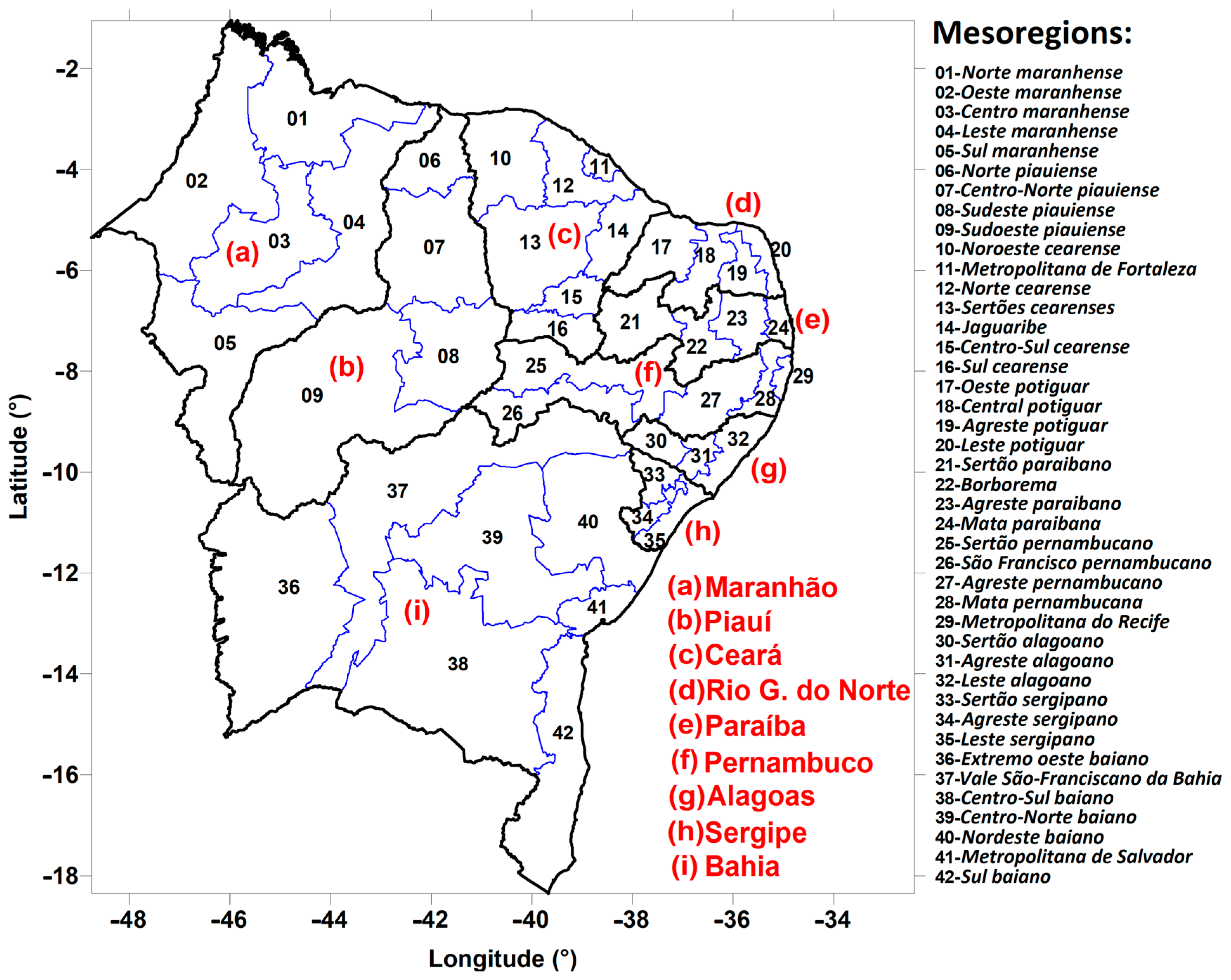

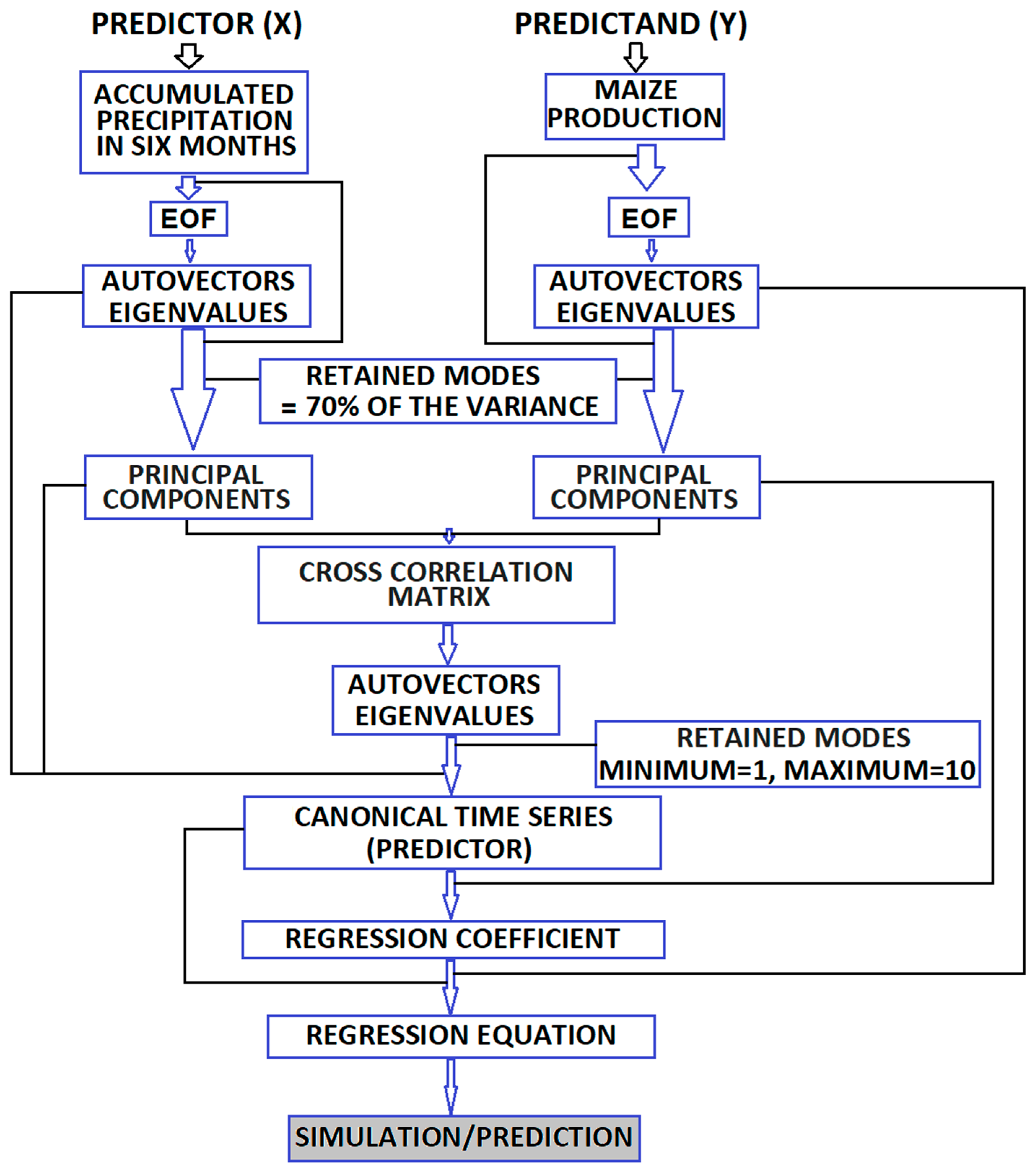



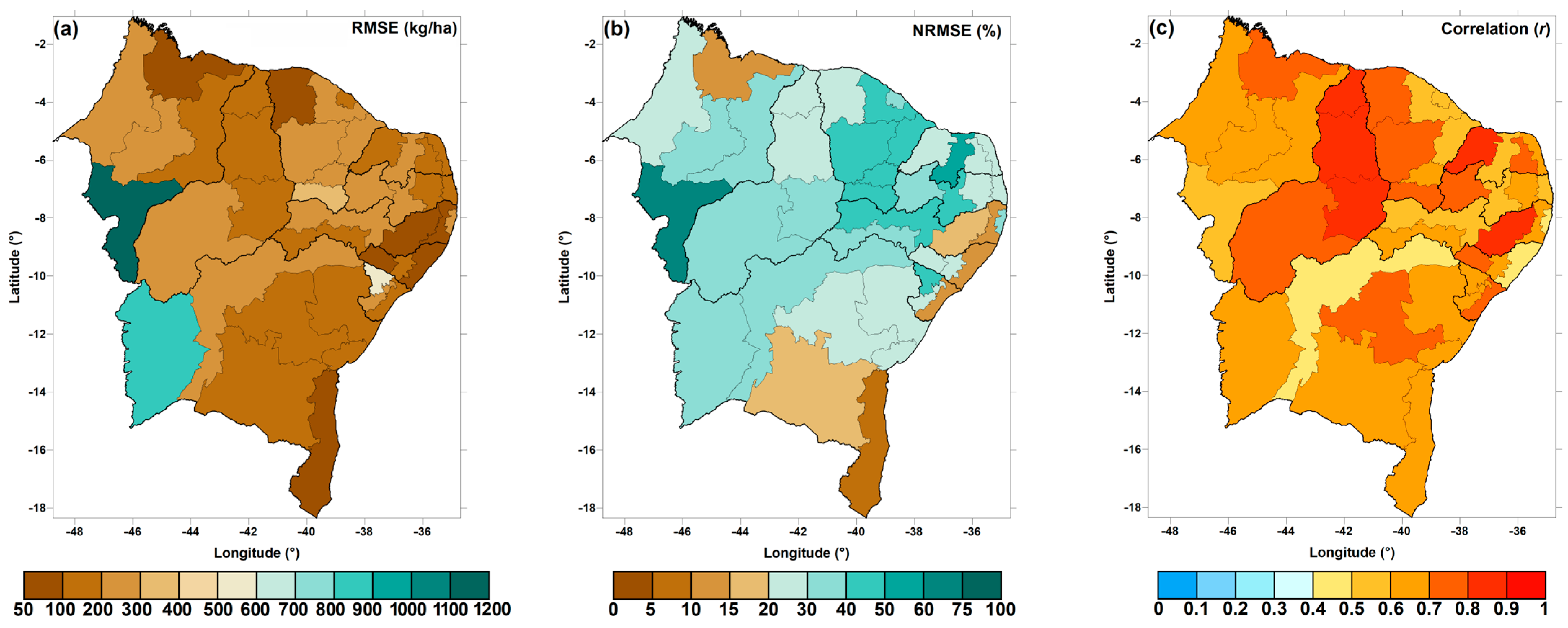
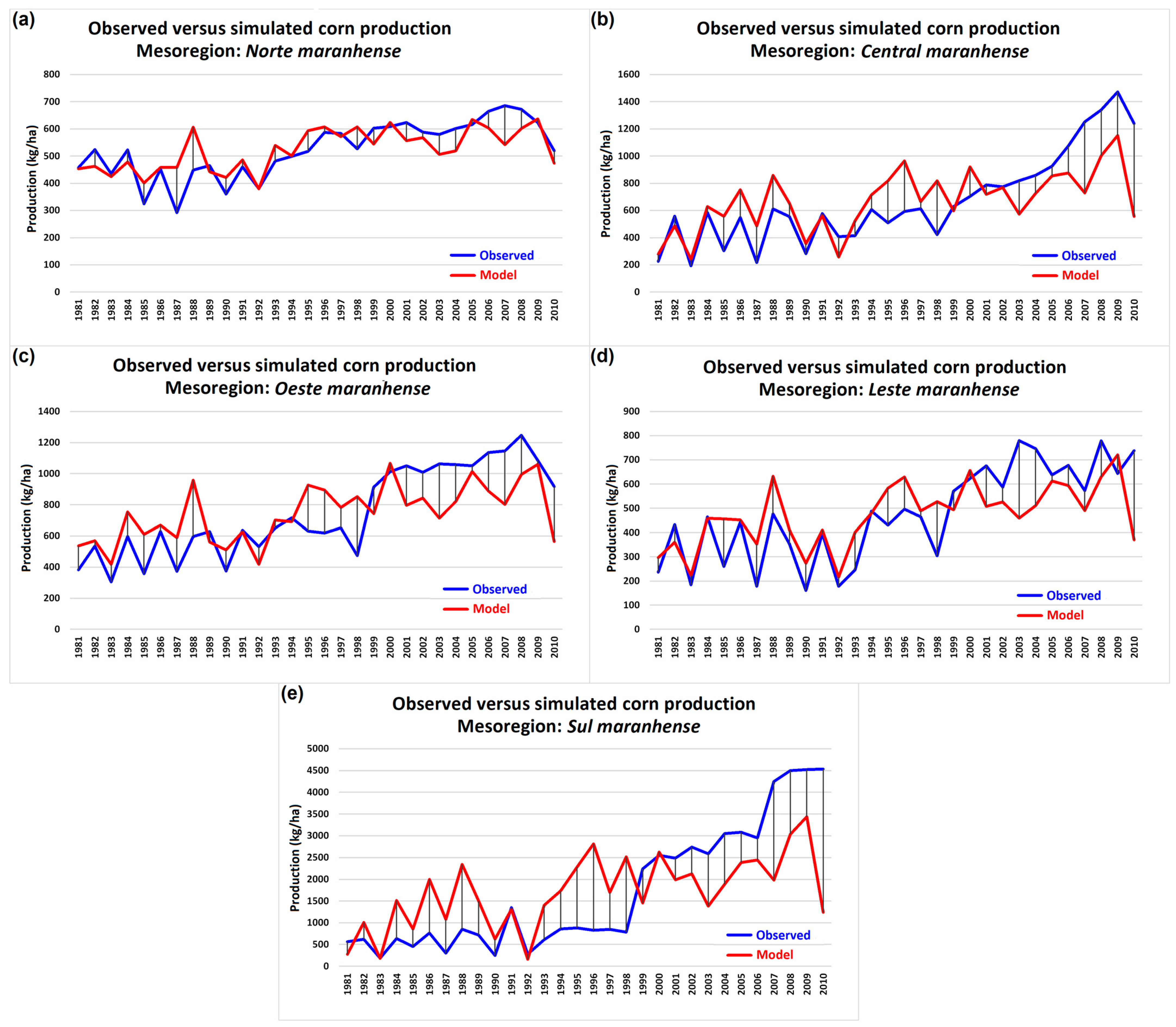

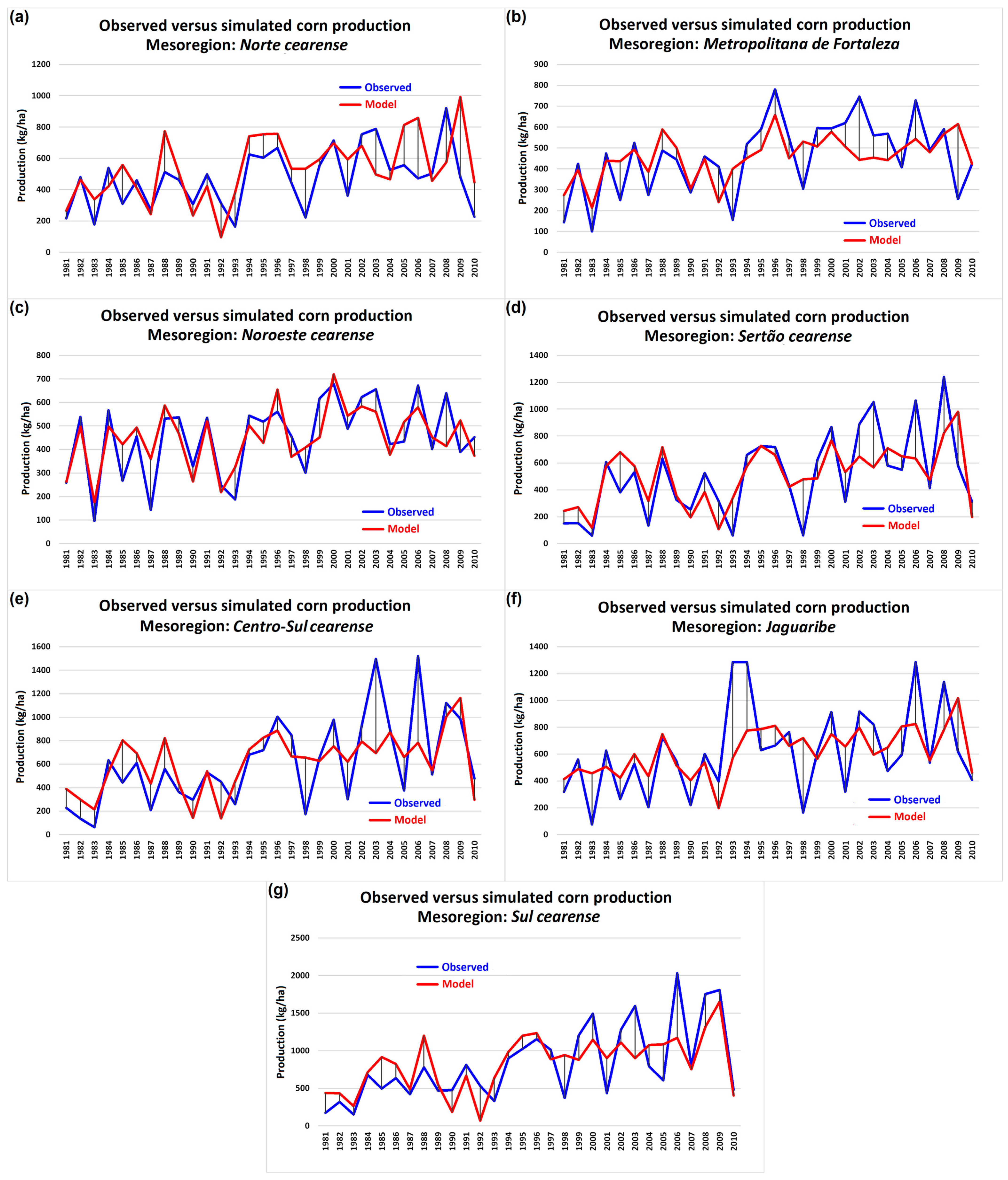
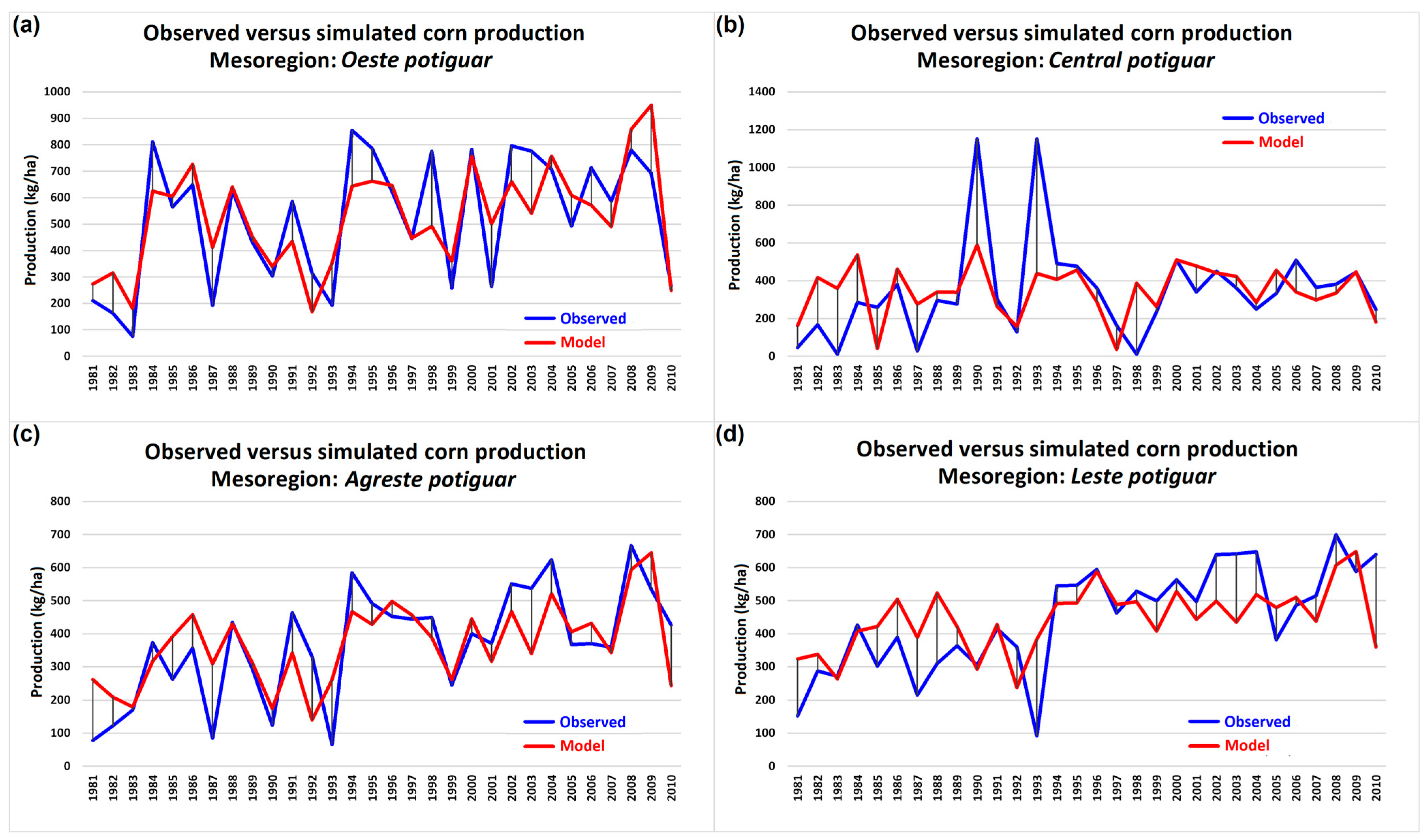
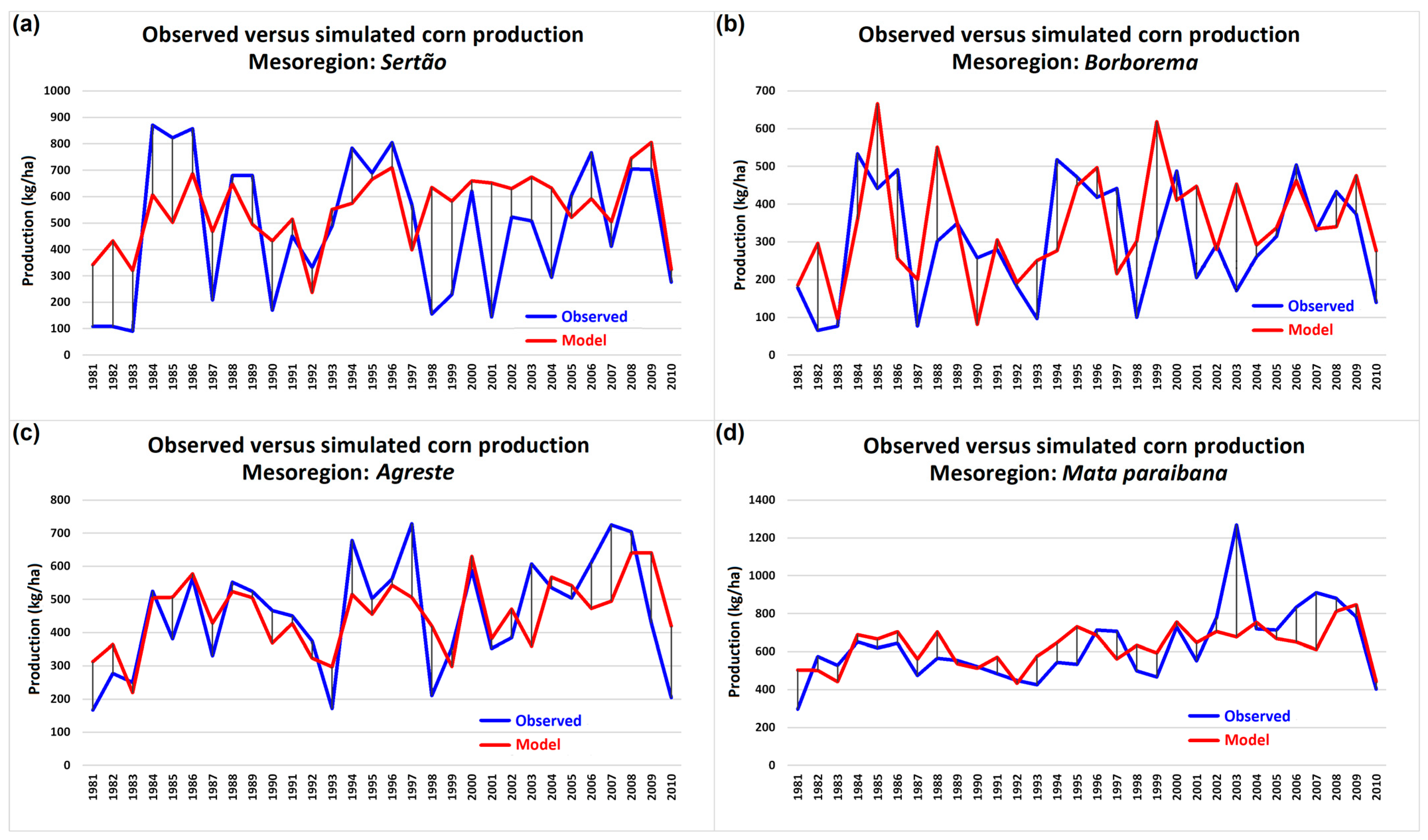
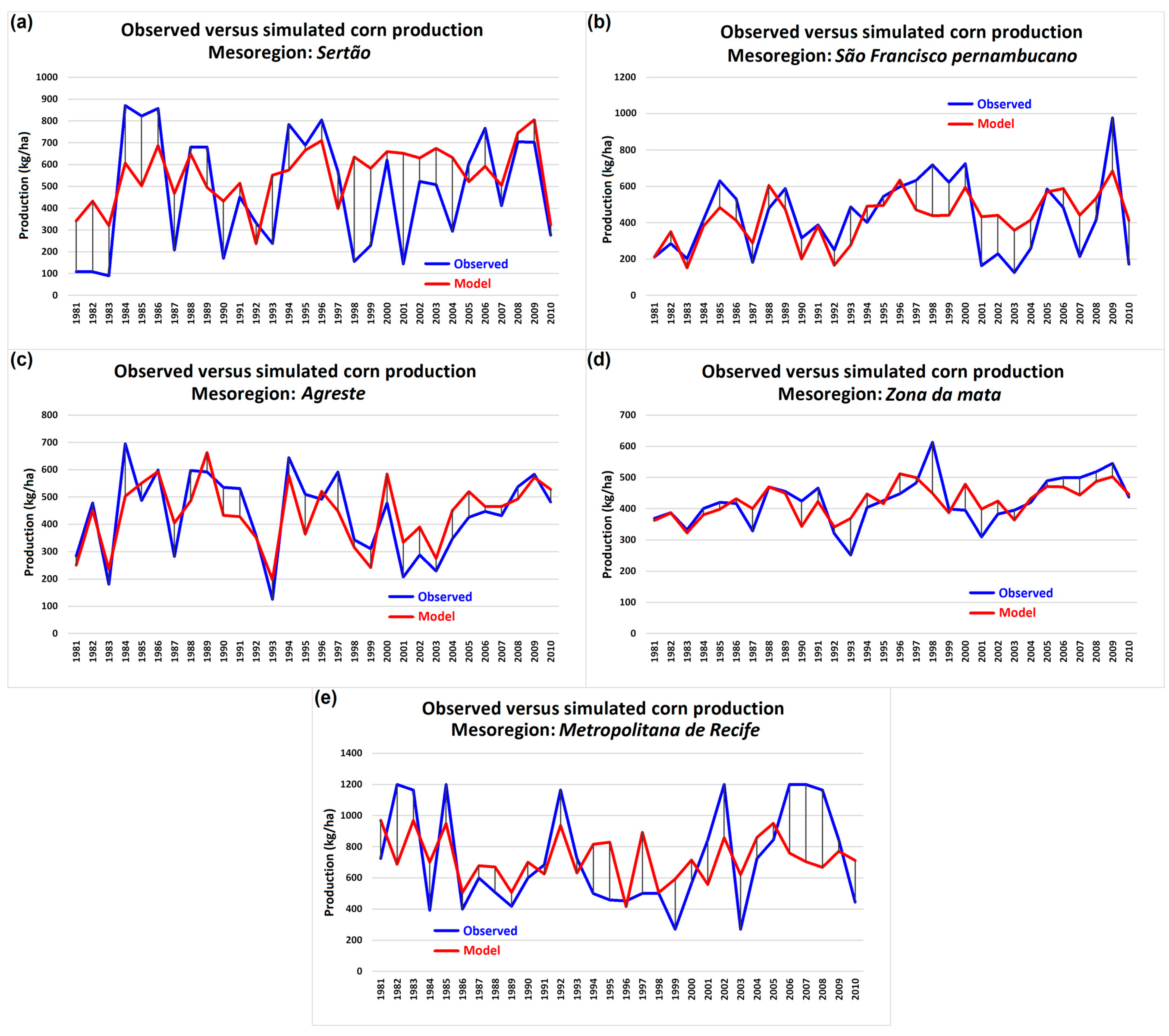

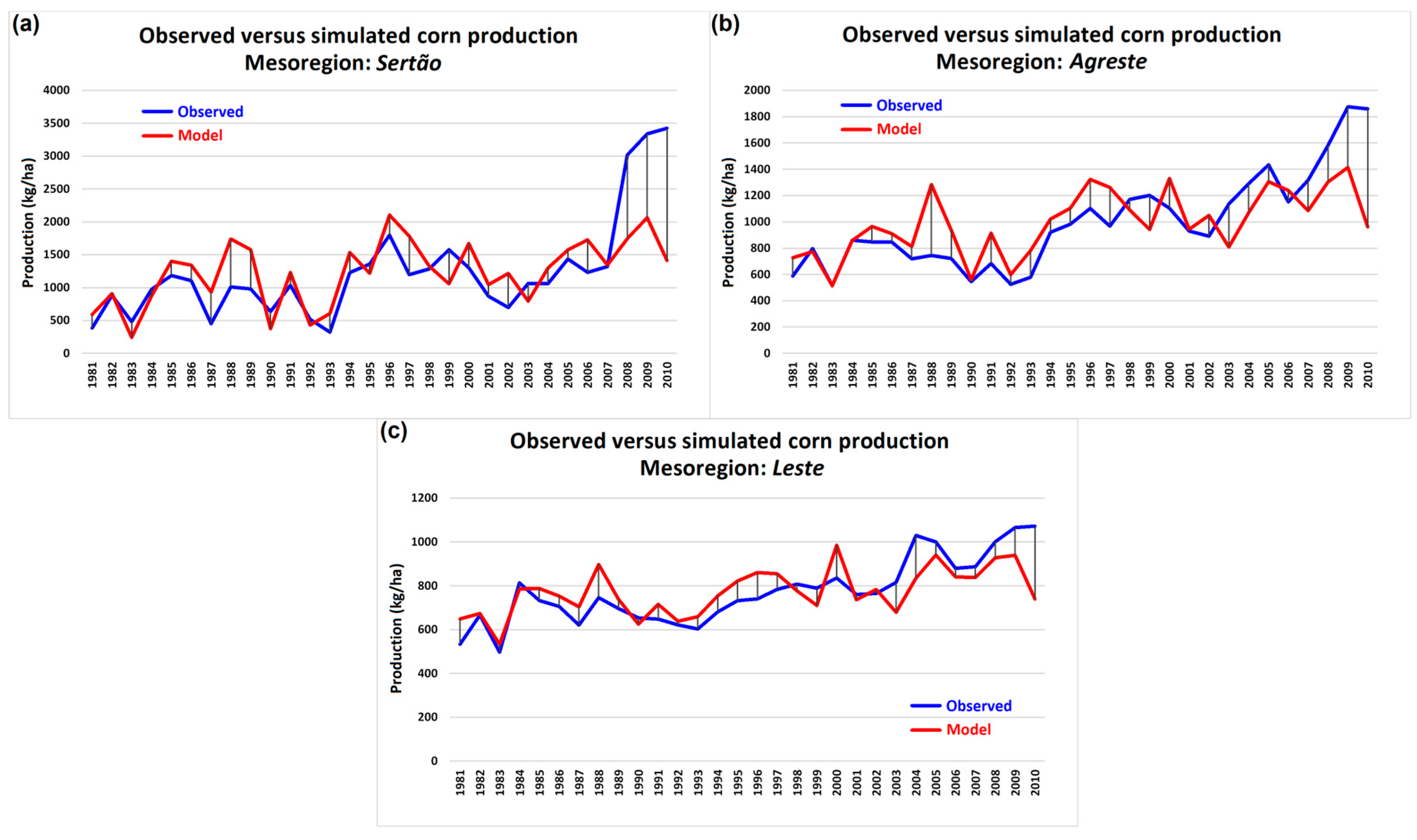
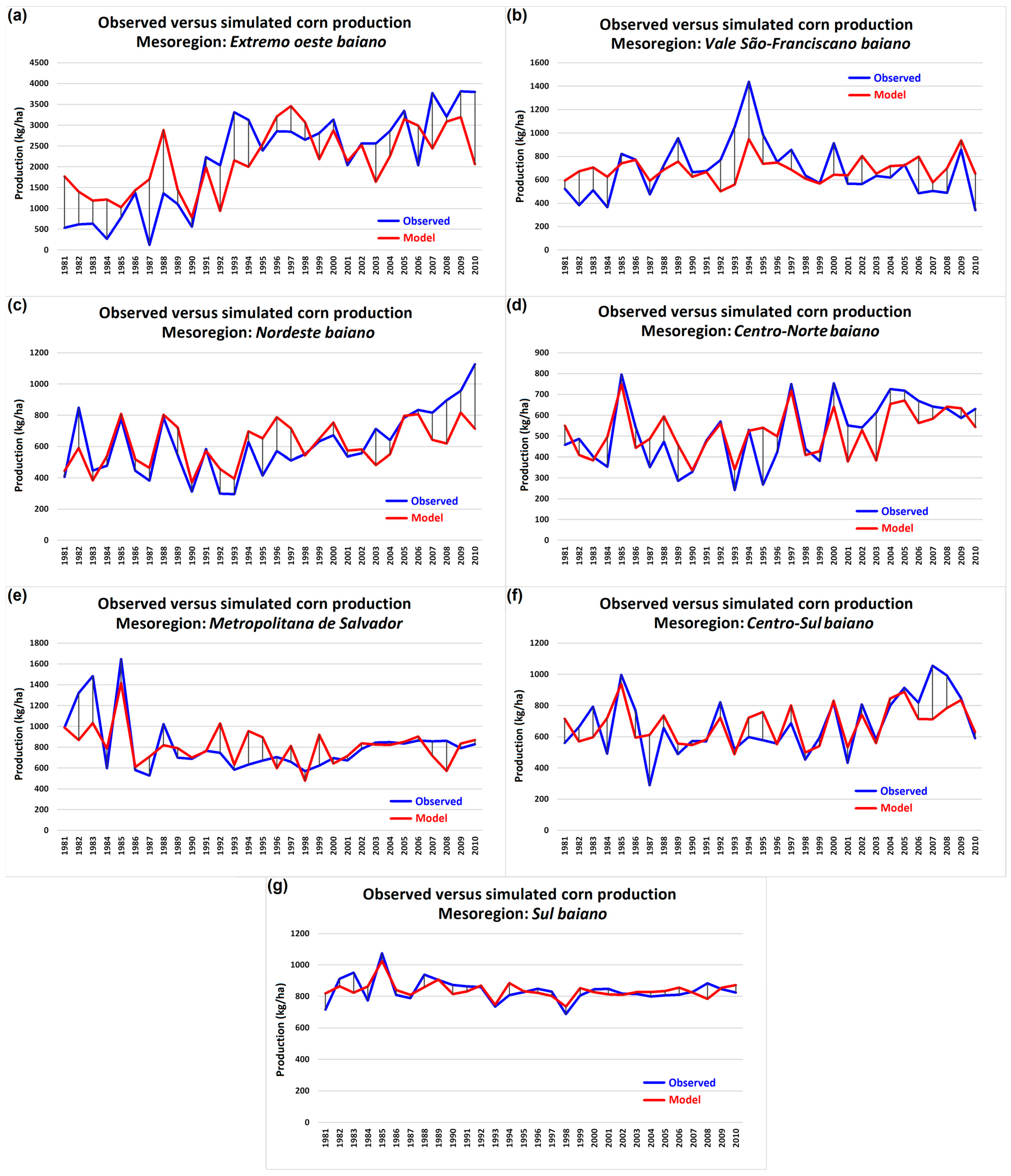

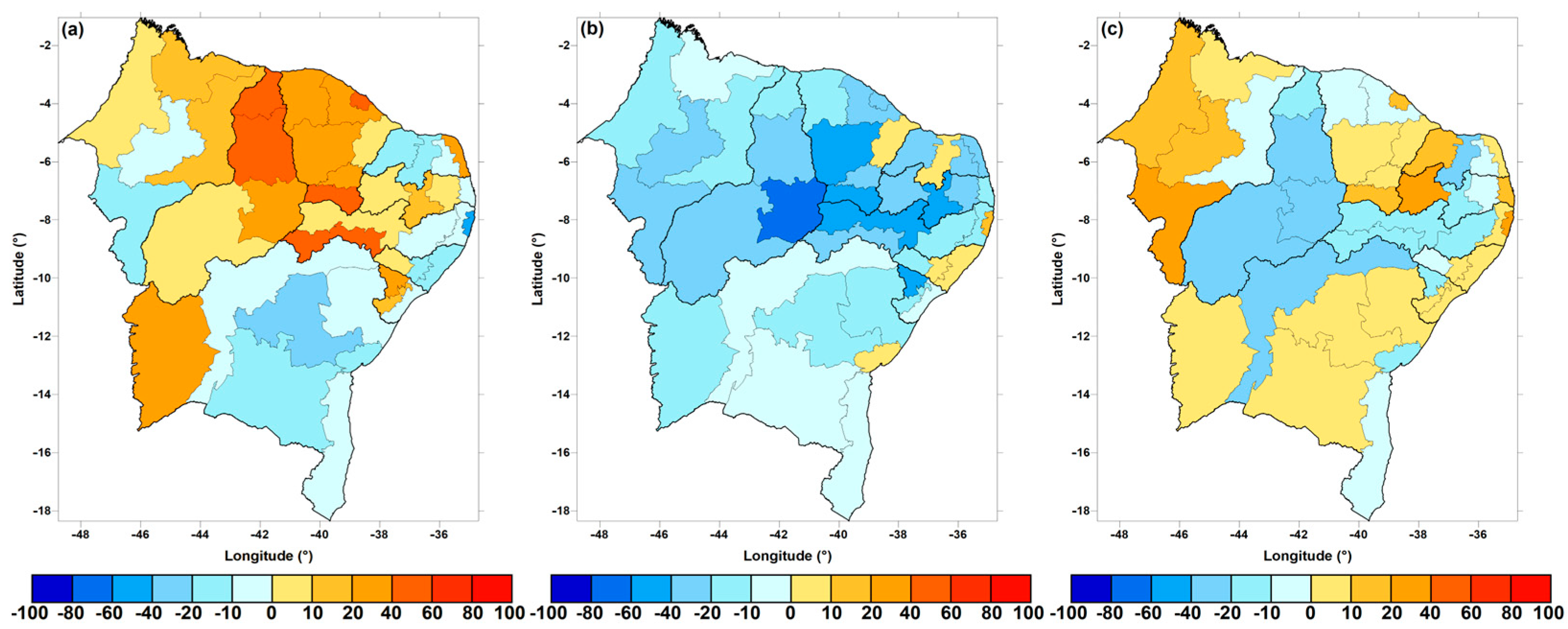
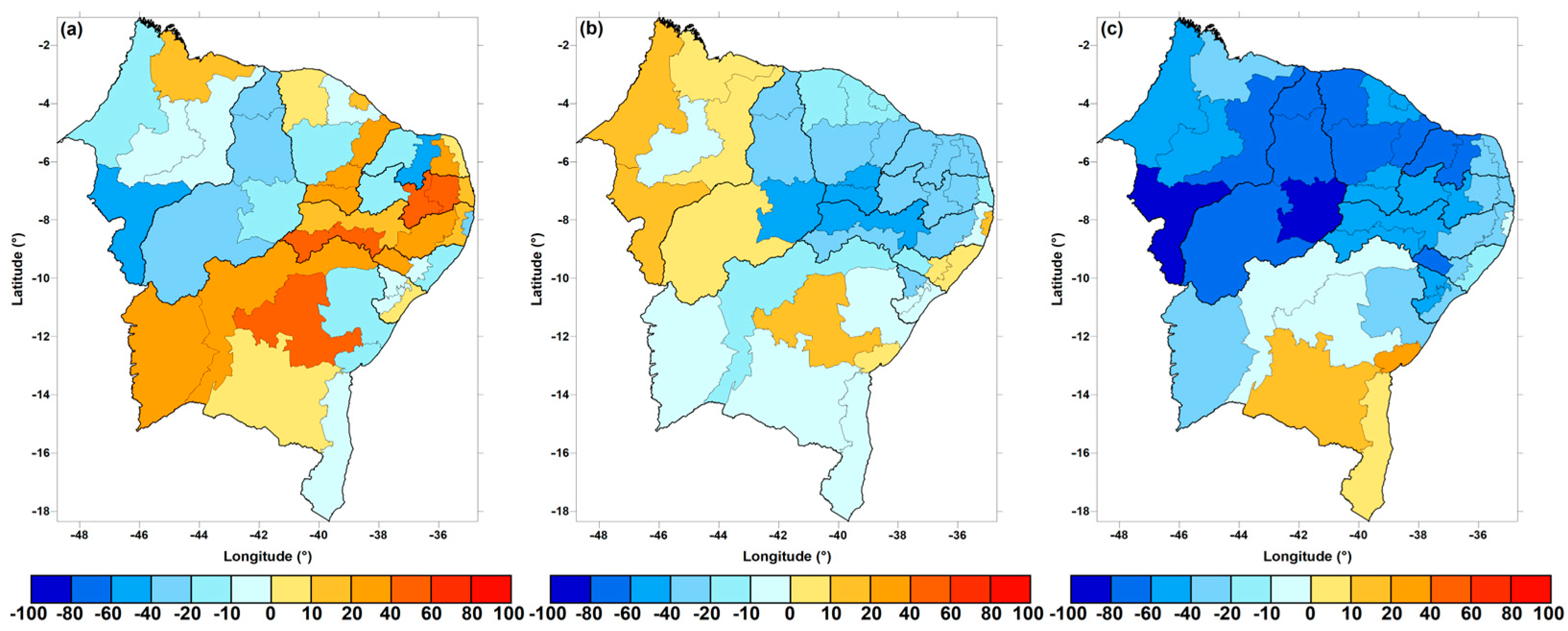
| Mesoregion | Rainy Season |
|---|---|
| Norte maranhense | |
| Oeste maranhense | |
| Central maranhense | |
| Leste maranhense | |
| Norte piauiense | |
| Centro Norte piauiense | |
| Sudeste piauiense | |
| Noroeste cearense | |
| Metropolitana de Fortaleza | |
| Norte cearense | |
| Sertões cearenses | January to June |
| Jaguaribe | (JFMAMJ) |
| Centro-Sul cearense | |
| Sul cearense | |
| Oeste potiguar | |
| Central potiguar | |
| Sertão paraibano | |
| Borborema | |
| Sertão pernambucano | |
| São-Francisco pernambucano | |
| Vale São Franciscano da Bahia | |
| Centro-Norte baiano | |
| Sul maranhense | |
| Sudoeste piauiense | October to March |
| Extremo oeste baiano | (ONDJFM) |
| Centro-Sul baiano | |
| Agreste potiguar | |
| Leste potiguar | |
| Agreste paraibano | |
| Mata paraibana | |
| Agreste pernambucano | |
| Mata pernambucana | |
| Metropolitana do Recife | |
| Sertão alagoano | April to September |
| Agreste alagoano | (AMJJAS) |
| Leste alagoano | |
| Sertão sergipano | |
| Agreste sergipano | |
| Leste sergipano | |
| Sul baiano | |
| Nordeste baiano | |
| Metropolitana de Salvador |
| Mesoregion | r—Accumulated Rainfall × Production | r—CCA Model × Production | RMSE (kg/ha) | NRMSE (%) |
|---|---|---|---|---|
| Norte maranhense | 0.45 | 0.74 | 68 | 13 |
| Oeste maranhense | 0.38 | 0.65 | 211 | 28 |
| Central maranhense | 0.47 | 0.66 | 247 | 37 |
| Leste maranhense | 0.44 | 0.66 | 143 | 30 |
| Sul maranhense | 0.37 | 0.56 | 1175 | 69 |
| Norte piauiense | 0.62 | 0.81 | 115 | 24 |
| Centro Norte piauiense | 0.66 | 0.82 | 129 | 27 |
| Sudeste piauiense | 0.71 | 0.83 | 188 | 38 |
| Sudoeste piauiense | 0.45 | 0.7 | 297 | 36 |
| Noroeste cearense | 0.33 | 0.78 | 99 | 22 |
| Norte cearense | 0.31 | 0.51 | 202 | 43 |
| Metropolitana de Fortaleza | 0.44 | 0.59 | 139 | 30 |
| Sertões cearenses | 0.5 | 0.7 | 218 | 43 |
| Jaguaribe | 0.37 | 0.53 | 274 | 44 |
| Centro-Sul cearense | 0.35 | 0.66 | 278 | 45 |
| Sul cearense | 0.5 | 0.73 | 343 | 41 |
| Oeste potiguar | 0.69 | 0.8 | 141 | 27 |
| Central potiguar | 0.64 | 0.52 | 153 | 52 |
| Agreste potiguar | 0.63 | 0.74 | 210 | 39 |
| Leste potiguar | 0.42 | 0.62 | 151 | 49 |
| Sertão paraibano | 0.43 | 0.76 | 231 | 48 |
| Borborema | 0.6 | 0.54 | 156 | 37 |
| Agreste paraibano | 0.63 | 0.65 | 208 | 30 |
| Mata paraibana | 0.5 | 0.56 | 105 | 20 |
| Sertão pernambucano | 0.76 | 0.53 | 832 | 39 |
| São-Francisco pernambucano | 0.39 | 0.65 | 134 | 20 |
| Agreste pernambucano | 0.75 | 0.81 | 109 | 30 |
| Mata pernambucana | 0.64 | 0.69 | 122 | 27 |
| Metropolitana do Recife | 0.35 | 0.48 | 123 | 27 |
| Sertão alagoano | 0.77 | 0.79 | 156 | 25 |
| Agreste alagoano | 0.62 | 0.63 | 86 | 20 |
| Leste alagoano | 0.2 | 0.42 | 54 | 13 |
| Sertão sergipano | 0.53 | 0.63 | 276 | 38 |
| Agreste sergipano | 0.43 | 0.67 | 591 | 48 |
| Leste sergipano | 0.34 | 0.71 | 266 | 27 |
| Extremo oeste Baiano | 0.17 | 0.68 | 103 | 13 |
| Vale São Franciscano da Bahia | 0.28 | 0.43 | 89 | 25 |
| Centro-Sul baiano | 0.16 | 0.67 | 124 | 22 |
| Centro-Norte baiano | 0.65 | 0.72 | 70 | 13 |
| Nordeste baiano | 0.62 | 0.67 | 52 | 6 |
| Metropolitana de Salvador | 0.36 | 0.68 | 150 | 24 |
| Sul baiano | 0.42 | 0.69 | 188 | 23 |
| Climate Combinations | Years |
|---|---|
| DipNeg/PacNeg | 1984, 1985, 1986, 1989, 2000, 2008 |
| DipNeg/PacNeu | 1991, 1994 |
| DipNeg/PacPos | 1988, 1995, 2003, 2009, 2010 |
| DipNeu/PacNeg | 1996, 1999 |
| DipNeu/PacNeu | 1982, 1990, 1993, 2004 |
| DipNeu/PacPos | 1987, 1998, 2002, 2006, 2007 |
| DipPos/PacNeg | 1997 |
| DipPos/PacNeu | 1980, 1981, 2001, 2005 |
| DipPos/PacPos | 1983, 1992 |
Disclaimer/Publisher’s Note: The statements, opinions and data contained in all publications are solely those of the individual author(s) and contributor(s) and not of MDPI and/or the editor(s). MDPI and/or the editor(s) disclaim responsibility for any injury to people or property resulting from any ideas, methods, instructions or products referred to in the content. |
© 2024 by the authors. Licensee MDPI, Basel, Switzerland. This article is an open access article distributed under the terms and conditions of the Creative Commons Attribution (CC BY) license (https://creativecommons.org/licenses/by/4.0/).
Share and Cite
Silva, F.D.d.S.; Peixoto, I.C.; Costa, R.L.; Gomes, H.B.; Gomes, H.B.; Cabral Júnior, J.B.; de Araújo, R.M.; Herdies, D.L. Predictive Potential of Maize Yield in the Mesoregions of Northeast Brazil. AgriEngineering 2024, 6, 881-907. https://doi.org/10.3390/agriengineering6020051
Silva FDdS, Peixoto IC, Costa RL, Gomes HB, Gomes HB, Cabral Júnior JB, de Araújo RM, Herdies DL. Predictive Potential of Maize Yield in the Mesoregions of Northeast Brazil. AgriEngineering. 2024; 6(2):881-907. https://doi.org/10.3390/agriengineering6020051
Chicago/Turabian StyleSilva, Fabrício Daniel dos Santos, Ivens Coelho Peixoto, Rafaela Lisboa Costa, Helber Barros Gomes, Heliofábio Barros Gomes, Jório Bezerra Cabral Júnior, Rodrigo Martins de Araújo, and Dirceu Luís Herdies. 2024. "Predictive Potential of Maize Yield in the Mesoregions of Northeast Brazil" AgriEngineering 6, no. 2: 881-907. https://doi.org/10.3390/agriengineering6020051








